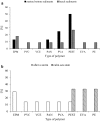Sources and fate of microplastics in marine and beach sediments of the Southern Baltic Sea-a preliminary study
- PMID: 28124265
- PMCID: PMC5383691
- DOI: 10.1007/s11356-017-8419-5
Sources and fate of microplastics in marine and beach sediments of the Southern Baltic Sea-a preliminary study
Abstract
Microplastics' (particles size ≤5 mm) sources and fate in marine bottom and beach sediments of the brackish are strongly polluted Baltic Sea have been investigated. Microplastics were extracted using sodium chloride (1.2 g cm-3). Their qualitative identification was conducted using micro-Fourier-transform infrared spectroscopy (μFT-IR). Concentration of microplastics varied from 25 particles kg-1 d.w. at the open sea beach to 53 particles kg-1 d.w. at beaches of strongly urbanized bay. In bottom sediments, microplastics concentration was visibly lower compared to beach sediments (0-27 particles kg-1 d.w.) and decreased from the shore to the open, deep-sea regions. The most frequent microplastics dimensions ranged from 0.1 to 2.0 mm, and transparent fibers were predominant. Polyester, which is a popular fabrics component, was the most common type of microplastic in both marine bottom (50%) and beach sediments (27%). Additionally, poly(vinyl acetate) used in shipbuilding as well as poly(ethylene-propylene) used for packaging were numerous in marine bottom (25% of all polymers) and beach sediments (18% of all polymers). Polymer density seems to be an important factor influencing microplastics circulation. Low density plastic debris probably recirculates between beach sediments and seawater in a greater extent than higher density debris. Therefore, their deposition is potentially limited and physical degradation is favored. Consequently, low density microplastics concentration may be underestimated using current methods due to too small size of the debris. This influences also the findings of qualitative research of microplastics which provide the basis for conclusions about the sources of microplastics in the marine environment.
Keywords: Beaches; Density separation; Microplastics; Pollution; Sediments; Southern Baltic.
Figures




Similar articles
-
Abundance and size of microplastics in a coastal sea: Comparison among bottom sediment, beach sediment, and surface water.Mar Pollut Bull. 2018 Aug;133:532-542. doi: 10.1016/j.marpolbul.2018.05.036. Epub 2018 Jun 19. Mar Pollut Bull. 2018. PMID: 30041347
-
Microplastics in Baltic bottom sediments: Quantification procedures and first results.Mar Pollut Bull. 2017 Jan 30;114(2):724-732. doi: 10.1016/j.marpolbul.2016.10.060. Epub 2016 Oct 31. Mar Pollut Bull. 2017. PMID: 27810093
-
Prevalence of microplastics in Singapore's coastal marine environment.Mar Pollut Bull. 2006 Jul;52(7):761-7. doi: 10.1016/j.marpolbul.2005.11.017. Epub 2006 Jan 4. Mar Pollut Bull. 2006. PMID: 16388828
-
Microplastic in the Baltic Sea: A review of distribution processes, sources, analysis methods and regulatory policies.Environ Pollut. 2022 Dec 15;315:120453. doi: 10.1016/j.envpol.2022.120453. Epub 2022 Oct 19. Environ Pollut. 2022. PMID: 36272601 Review.
-
Microplastics in the marine environment: a review of the methods used for identification and quantification.Environ Sci Technol. 2012 Mar 20;46(6):3060-75. doi: 10.1021/es2031505. Epub 2012 Mar 2. Environ Sci Technol. 2012. PMID: 22321064 Review.
Cited by
-
Spatiotemporal distribution of microplastic debris in the surface beach sediment of the southeastern coast of Bangladesh.Heliyon. 2023 Nov 17;9(11):e21864. doi: 10.1016/j.heliyon.2023.e21864. eCollection 2023 Nov. Heliyon. 2023. PMID: 38058634 Free PMC article.
-
Potent Impact of Plastic Nanomaterials and Micromaterials on the Food Chain and Human Health.Int J Mol Sci. 2020 Mar 3;21(5):1727. doi: 10.3390/ijms21051727. Int J Mol Sci. 2020. PMID: 32138322 Free PMC article. Review.
-
Occurrence and identification of microplastics in beach sediments from the Hauts-de-France region.Environ Sci Pollut Res Int. 2019 Sep;26(27):28010-28021. doi: 10.1007/s11356-019-06027-8. Epub 2019 Jul 27. Environ Sci Pollut Res Int. 2019. PMID: 31352600
-
Micro-Nano Plastic in the Aquatic Environment: Methodological Problems and Challenges.Animals (Basel). 2022 Jan 25;12(3):297. doi: 10.3390/ani12030297. Animals (Basel). 2022. PMID: 35158621 Free PMC article.
-
Well-Being of the Baltic Herring and Bycatch Fish Species from FAO Major Fishing Areas 27 According to Microplastic Pollution.Animals (Basel). 2025 Aug 13;15(16):2381. doi: 10.3390/ani15162381. Animals (Basel). 2025. PMID: 40867710 Free PMC article.
References
-
- Bjorndal KA, Bolten AB, Lagueux CJ. Ingestion of marine debris by juvenile sea turtles in coastal Florida habitats. Mar Pollut Bull. 1994;28(3):154–158. doi: 10.1016/0025-326X(94)90391-3. - DOI
-
- Browne MA. Sources and pathways of microplastics to habitats. In: Bergmann M, Gutov L, Klages M, editors. Marine anthropogenic litter. Berlin: Springer; 2015. pp. 229–245.
MeSH terms
Substances
LinkOut - more resources
Full Text Sources
Other Literature Sources

